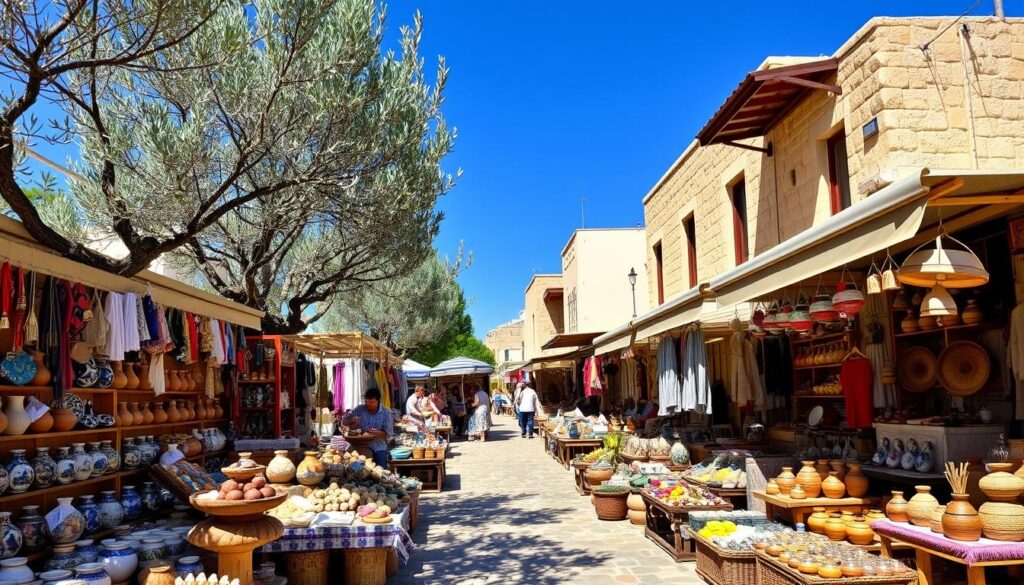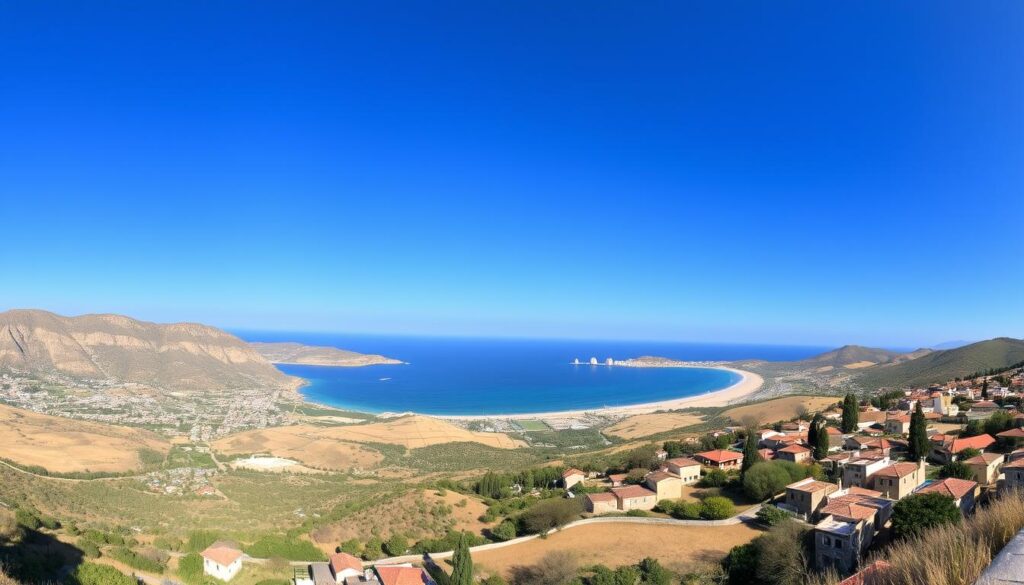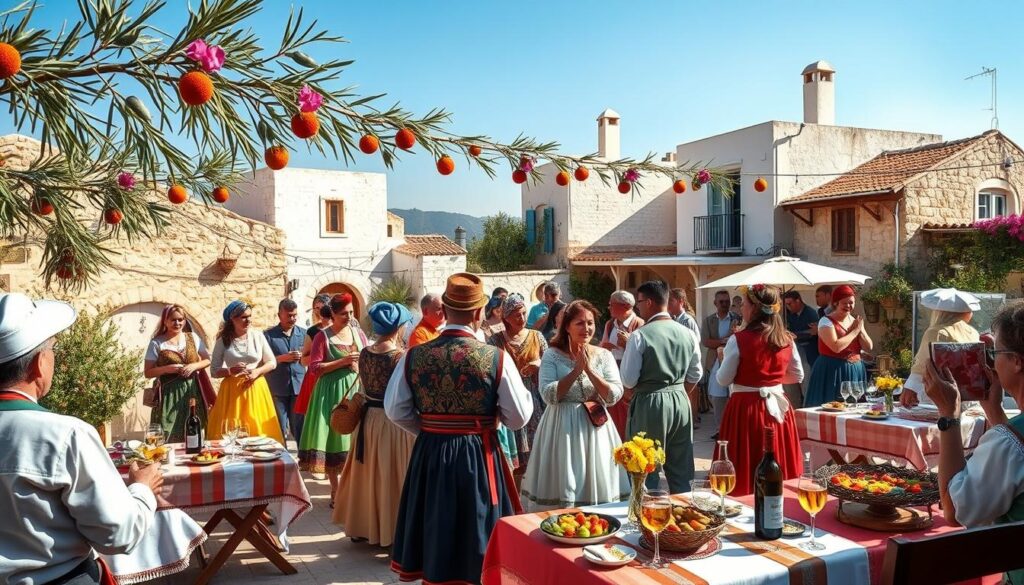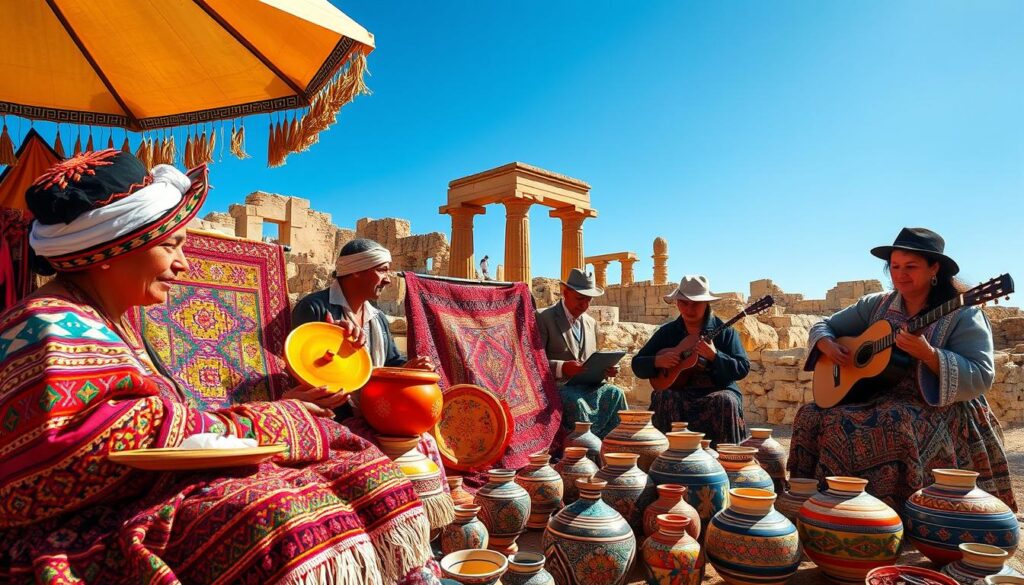Cyprus, a stunning island in the eastern Mediterranean, offers a captivating glimpse into its vibrant culture shaped by a mix of historical influences. With a population estimated at 1,336,000, this small yet diverse nation showcases both Greek and Turkish traditions that have coexisted for centuries1. The intricate tapestry of Cyprus Culture is adorned with customs, languages, and celebrations, reflecting its Mediterranean heritage. From the Byzantine and Venetian eras to Ottoman rule, each chapter of history contributes to the island’s unique cultural identity. Visitors can explore the lively festivals, delicious culinary delights, and rich artistic expressions that define Cypriot traditions. This article will take you on a journey through the enchanting facets of Cyprus Culture and reveal why it remains a remarkable destination for all2.
Key Takeaways
- Cyprus has a diverse population of approximately 1,336,000 people.
- The island’s culture features a unique blend of Greek and Turkish traditions.
- Religious and secular festivals are vibrant components of Cyprus Culture.
- Traditional music prominently features instruments like the laouto and saz.
- Iconic dishes such as halloumi cheese are staples of Cypriot cuisine.
- Handicrafts, including Lefkara lace, reflect the island’s rich artistic heritage.
Introduction to Cyprus Culture and Traditions
The captivating Cyprus Culture is a rich tapestry woven from the island’s long and intricate history. For over 3,000 years, various civilizations have influenced the traditions that still thrive today. From ancient Mycenaean Greeks to the Ottoman Empire, the historical complexity has birthed a unique blend of Greek and Turkish influences that shape the island lifestyle of contemporary Cypriots3.
Cyprus boasts an estimated population of 1.1 million, predominantly composed of Greek Cypriots (77%) and Turkish Cypriots (18%), with other ethnic groups comprising the remaining 5%4. The linguistic landscape is equally diverse, as around 84% speak Greek while approximately 13% communicate in Turkish, reflecting the island’s cultural duality4.
Religion plays a significant role in daily life, where the Greek Orthodox faith is observed by 78% of the populace, and Muslim practices are followed by 18%4. Understanding the Cyprus Culture demands an appreciation of these religious frameworks alongside local customs, including the celebration of festivals, culinary practices, and the unique aspects of family life.

Overall, Cyprus serves as a living museum where the rich heritage and vibrant traditions invite both locals and visitors to explore the dynamics of its cultural evolution. The blend of Greek and Turkish influences continues to create a dynamic and engaging island lifestyle that captures the essence of what it means to be Cypriot today.
Geographic and Demographic Overview of Cyprus
Cyprus, strategically situated in the eastern Mediterranean, serves as a vital hub of cultural intersections and human exchanges. This island, covering a total area of 9,251 sq km, reflects its historical significance as a geographic crossroads where various civilizations converged. The Mediterranean crossroads nature has profoundly shaped its cultural dynamics, evident in the layers of influences from the Greek, Phoenician, Roman, and Ottoman empires, among others. Such a rich history has created a tapestry of traditions and social norms that resonate across generations.
Location and Influence of Civilizations
The geographic overview of Cyprus underscores its crucial position south of Turkey and west of Syria and Lebanon. This location has historically attracted various civilizations that contributed to the island’s diverse cultural heritage. The influence of past rulers can be observed in architectural styles, language, and customs that persist in modern Cypriot society. For instance, the mix of Eastern Orthodox Christianity and Sunni Islam illustrates the historical interactions between Greek and Turkish cultures.
Population Diversity: Greek and Turkish Cypriots
As of 2024, the population of Cyprus is estimated to be approximately 1,336,000, with Greek Cypriots constituting nearly 80% and Turkish Cypriots making up roughly 20% of the island’s inhabitants5. Such demographic diversity helps paint a vivid picture of the island’s identity, showcasing variations in traditions, cuisine, and social customs. The fertility rate stands at 1.48 children per woman, resulting in a balanced age distribution with 15.69% of the population aged 0-14 years and 12.97% aged 65 and over6. The island’s low illiteracy rate is attributed to a robust educational system, making it one of the more literate populations in the region5. Additionally, residents enjoy a high life expectancy of 79.74 years, with notable distinctions between genders6. This demographic tapestry emphasizes the island’s cultural vibrancy and the significance of its Mediterranean crossroads heritage.

Cyprus Culture: Festivals and Celebrations
Cyprus is rich in cultural celebrations that highlight the island’s history and traditions. Each year, numerous religious festivals and events unfold, showcasing the community’s spirit and cultural heritage. These vibrant occasions allow both residents and visitors to immerse themselves in the island’s unique customs.
Major Religious Festivals
One of the most significant religious festivals is Orthodox Easter, celebrated with great enthusiasm across the island. This period features traditional customs, including special church services, preparation of monks and colorful eggs, reflecting local Cypriot traditions. The blending of different communities, such as Greek Orthodox and Turkish Muslims, contributes to a rich tapestry of spiritual observance on holidays that are respected by all.
Seasonal Celebrations and Folk Events
Seasonal cultural celebrations like the Anthestiria Flower Festival welcome spring with activities that celebrate the bond with nature. The Limassol Wine Festival offers a delightful experience where visitors can taste local wines while enjoying traditional dance and theatrical performances, making it a highlight of the year. These events foster a strong sense of community and keep alive the Cypriot traditions that have been passed down through generations.

| Festival | Key Features | Time of Year |
|---|---|---|
| Orthodox Easter | Church services, decorated eggs, special dishes like flaounes | Spring |
| Anthestiria Flower Festival | Celebration of flowers, local crafts, community events | Spring |
| Limassol Wine Festival | Tasting wines, traditional dances, culinary experiences | September |
| Kypria Festival | Art performances, local and international artists | September-October |
By participating in these festivities, one can truly appreciate the depth of Cyprus’s culture, where each event is a testament to rich Cypriot traditions and enduring communal ties7.
Artistic Expressions in Cypriot Culture
The diverse artistic expressions found in Cypriot culture reflect a rich tapestry of tradition and modernity. From traditional music and dance that celebrated local history to the innovative realms of contemporary art in Cyprus, these forms of art play a crucial role in the social fabric of the island.
Traditional Music and Dance
Traditional music and dance in Cyprus act as vital expressions of cultural identity. Music often features instruments such as the saz and lyre, which contribute to the distinct sound that characterizes many folk gatherings. Folk dances like the syrtos and kalamatianos engage the community, allowing locals and visitors to participate in joyous celebrations. These practices not only preserve the past but also initiate a shared experience among generations and different backgrounds.
The Role of Contemporary Art
The vibrant scene of contemporary art in Cyprus showcases the island’s ongoing evolution. Artists draw inspiration from traditional motifs while experimenting with modern techniques to express their visions. Galleries and art exhibitions are increasingly common in urban centers, highlighting the significance of both local and international influences. This blend fosters a platform where historical and modern artistic expressions coexist, enriching the cultural landscape.

| Art Form | Description | Significance |
|---|---|---|
| Traditional Music | Involves instruments like the saz and lyre, with folk genres reflecting Cypriot heritage. | Enhances community ties and reinforces cultural identity. |
| Folk Dance | Includes styles such as syrtos and kalamatianos, often performed at festivals. | Encourages social participation and fosters intergenerational connections. |
| Contemporary Art | Represents a fusion of local traditions and modern practices across various media. | Offers insights into Cypriot society’s evolution and intercultural dialogue. |
Artistic expressions in Cyprus reveal a deep-seated appreciation for both cultural heritage and innovation, showcasing the island’s unique character in the realm of music and dance, as well as the broader contemporary art scene8.
Exploring Cypriot Cuisine: A Gastronomic Journey
Cypriot cuisine offers a rich tapestry of flavors, drawing from its historical crossroads between Europe, Asia, and Africa. This culinary journey embraces a blend of Greek and Turkish culinary traditions, utilizing local ingredients to create memorable dishes that epitomize Mediterranean flavors.
Key Dishes and Culinary Traditions
Iconic dishes such as souvlaki, moussaka, kleftiko, and koupepia highlight the fondness for lamb in Greek Cypriot cooking9. Olive oil reigns supreme as a staple ingredient, enhancing the flavors of almost every dish9. In contrast, Turkish-Cypriot cuisine showcases beloved offerings like kebabs and pide, enriched by spices such as sumac, cumin, and paprika9. The local agricultural abundance supports seasonal crops, ensuring fresh ingredients are widely available10.
A true emblem of Cypriot cuisine, Halloumi cheese finds its way into various meals, showcasing its versatility10. Traditional dips such as hummus and tzatziki serve as perfect accompaniments, presenting a delightful introduction to Mediterranean flavors10. Another popular dish, stifado, features tender meat slow-cooked with onions and tomatoes, reflecting the island’s influences from Turkish and Middle Eastern cuisines10.
The Social Experience of Meze
The meze meal is a central social experience in Cypriot dining, comprising numerous small plates that allow diners to sample a variety of dishes11. This communal approach fosters sharing and connection among friends and family. Some popular meze items include grilled lamb kebabs and delicious halloumi11, as well as delectable seafood dishes like grilled sea bass and octopus stifado, highlighting the island’s abundant maritime resources11.
Street food options, such as souvlaki served in pitta with tzatziki, provide affordable and delicious quick eats, showcasing a significant aspect of local culture9. Vegetarian dishes, embracing flavors from fresh vegetables and herbs, play an essential role as well, catering to growing trends in plant-based diets9. Festivals celebrating these culinary delights further enrich Cyprus’s reputation as a premier destination for food enthusiasts10.
Handicrafts and Folk Arts in Cyprus
Cyprus boasts a strong tradition of handicrafts and folk arts that beautifully capture the island’s cultural essence. Visitors can find a variety of exquisite handicrafts that reflect the traditional craftsmanship passed down through generations. The rich history of these arts is evident in the intricate creations made by local artisans, particularly in Lefkara Village.
Iconic Craftsmanship from Lefkara Village
Lefkara Village is world-renowned for its delicate lacework known as Lefkaritika, a tradition inspired by the Venetians during their occupation of Cyprus from 1489 to 1570. This precise art form has been practiced for centuries, with traditional Cypriot girls expected to prepare a collection of Lefkara Lace as a showcase for their wedding day, continuing a legacy handed down from mother to daughter12. Made from linen and thread, Lefkara Lace features intricate patterns created through techniques like hemstitch and satin stitch fillings. Authentic pieces are identified by their craftsmanship, where there is no distinguishable difference between the front and back12. Today, this lace is recognized as part of UNESCO’s Intangible World Heritage and is celebrated for its exquisite details.
Turkish Influence on Handicrafts
The Turkish Cypriot community contributes significantly to Cyprus’s diverse handicraft scene. Their craftsmanship includes notable traditions such as silversmithing and pottery, which showcase the region’s historical influences. An example is the charmingly designed Yemeni headscarves, once a symbol of wealth among Turkish Cypriot women. Another striking craft is the Kilim rugs, handwoven primarily in villages around Famagusta. These rugs are not mere decorative items but are considered works of art, with some fetching prices reaching five or six figures12.
Visitors interested in Cyprus’s cultural heritage can explore the Cyprus Folk Art Museum, founded in 1937, which boasts a collection exceeding 5,000 artifacts reflecting the island’s artistic traditions. The museum displays a variety of items, including pottery, textiles, and metalwork, emphasizing the importance of preserving these traditional art forms13. The craftsmanship found in the museum highlights the interconnectedness of both communities and their unique contributions to the rich tapestry of Cypriot culture.
Conclusion
The rich tapestry of Cyprus Culture reflects a unique integration of diverse historical influences and vibrant traditions. With a population estimate of 1,336,000 in 2024, Cyprus stands as the third largest Mediterranean island, celebrated for its beautiful landscapes and unique heritage. The coexistence of Greek and Turkish Cypriots showcases both a struggle and a beauty in its cultural heritage, evidenced by their varied festivals, culinary delights, and distinctive craftsmanship.
The festivals and celebrations, emblematic of both communities, highlight not only the enjoyment stemming from traditions but also the deeper significance tied to national identity. As highlighted by historical data, in 1960, approximately 77% of the population was Greek Cypriots, while 18.3% were Turkish Cypriots, each contributing to the rich cultural tapestry of the island14. This vivid integration of traditions fosters a strong sense of community, both in celebration and in daily life, where people thrive in the melding of distinct cultural practices.
As travelers delve into the heart of Cyprus, they engage with a living history, enriching their understanding of this remarkable destination. Whether indulging in traditional dishes, witnessing artistic creations, or participating in local customs, visitors are warmly invited to experience the enduring vitality of Cypriot culture. In essence, Cyprus is not merely a location but a powerful testament to the strength and richness of its cultural identity, illuminating its vital role within the Mediterranean region15 and its remarkable belonging to a shared global heritage.
FAQ
What are the main influences on Cyprus Culture?
Cyprus Culture is primarily influenced by its historical complexities stemming from Greek and Turkish civilizations, as well as legacies from Byzantine, Venetian, and Ottoman rule.
What are some popular festivals celebrated in Cyprus?
Major festivals in Cyprus include Orthodox Easter, celebrated with unique customs, and Anthestiria, a flower festival that marks the arrival of spring. Other local fairs and agricultural festivals also play a significant role in the island’s cultural celebrations.
What is the significance of Cypriot cuisine?
Cypriot cuisine reflects the island’s Mediterranean heritage, combining Greek and Turkish flavors. Dishes like Halloumi cheese, souvlaki, and meze highlight the culinary traditions that promote communal dining and local ingredients.
Where can I experience traditional arts and crafts in Cyprus?
Lefkara Village is famous for its delicate lacework known as Lefkaritika, while Turkish Cypriots are known for their silversmithing and pottery, showcasing the island’s rich heritage in handicrafts.
How is music incorporated into Cypriot culture?
Music plays a vital role in Cypriot culture with traditional genres influenced by both Greek and Turkish styles. Instruments like the saz and lyre are commonly used during social gatherings and festivals, complementing folk dances.
What is the demographic diversity of Cyprus like?
Cyprus has approximately 1.1 million residents, comprising predominantly Greek Cypriots (77%) and Turkish Cypriots (18%), along with other ethnic groups, reflecting its rich cultural fabric.
How important are religious festivals in Cyprus?
Religious festivals are central to Cyprus Culture, serving to strengthen community ties and preserve traditions. Festivals like Orthodox Easter encompass unique customs that reflect the island’s rich religious heritage.
Source Links
- https://www.britannica.com/place/Cyprus/Cultural-life
- https://cyprus-magazine.com/an-insider-s-guide-to-cyprus-cultural-traditions/
- https://www.iexplore.com/articles/travel-guides/middle-east/cyprus/history-and-culture
- https://www.commisceo-global.com/resources/country-guides/cyprus-guide
- https://www.britannica.com/place/Cyprus/People
- https://en.wikipedia.org/wiki/Demographics_of_Cyprus
- https://www.cyprusvisa.co.uk/best-cultural-events-festivals-in-cyprus/
- https://www.metmuseum.org/toah/hd/pcyp/hd_pcyp.htm
- https://dom.com.cy/en/live/blog/delicious-cyprus-a-culinary-journey-through-the-island-of-aphrodite/
- https://www.wandersmiles.com/traditional-foods-of-cyprus/
- https://elegantcyprusproperties.com/indulge-in-the-culinary-delights-of-cyprus-exploring-the-vibrant-cypriot-cuisine/
- https://www.visitncy.com/kesfet/geleneksel-el-sanatlari/
- https://cyprustravellerguide.com/the-cyprus-folk-art-museum-in-nicosia/
- https://www.everyculture.com/Cr-Ga/Cyprus.html
- https://www.britannica.com/place/Cyprus

Comments